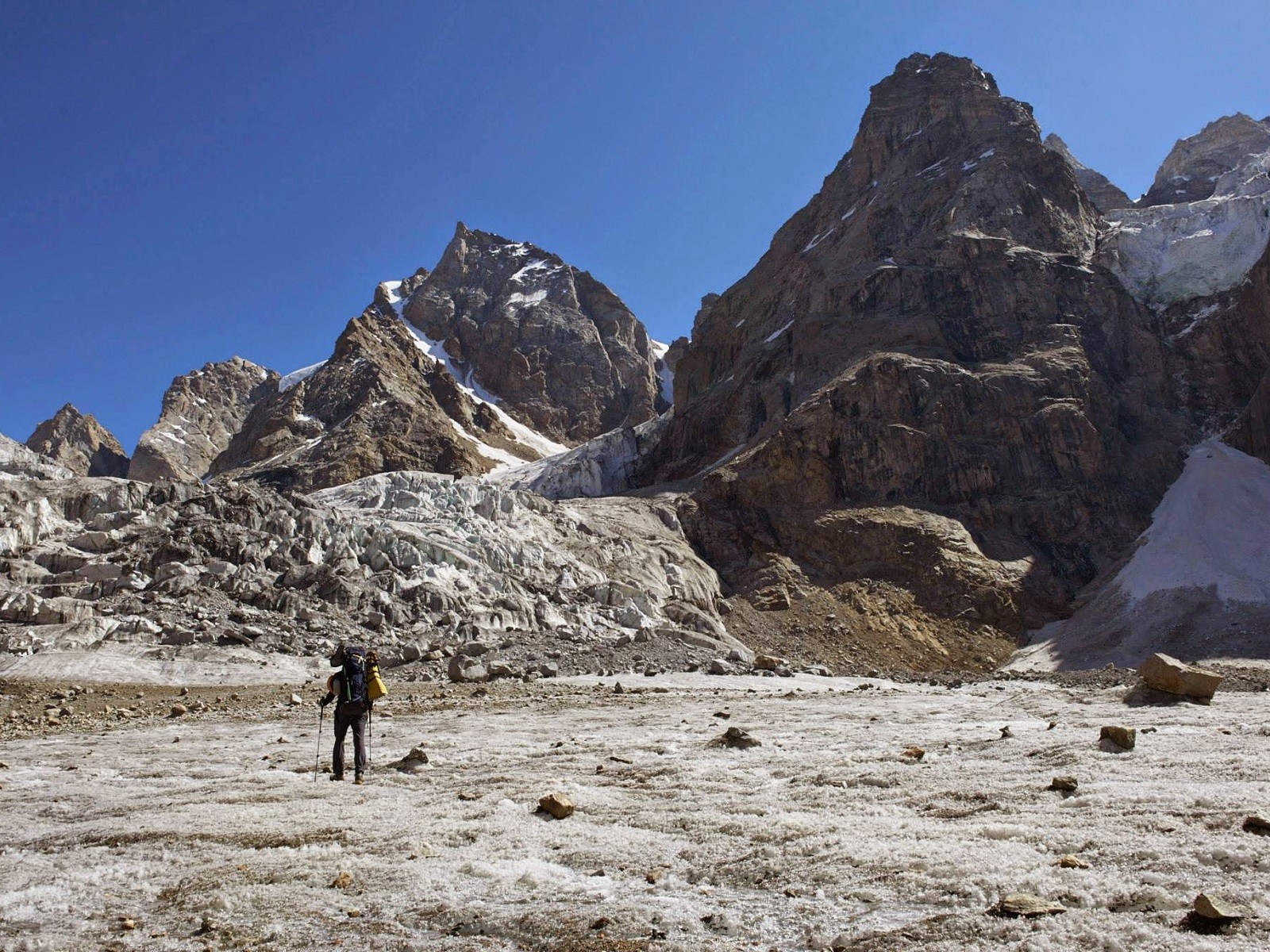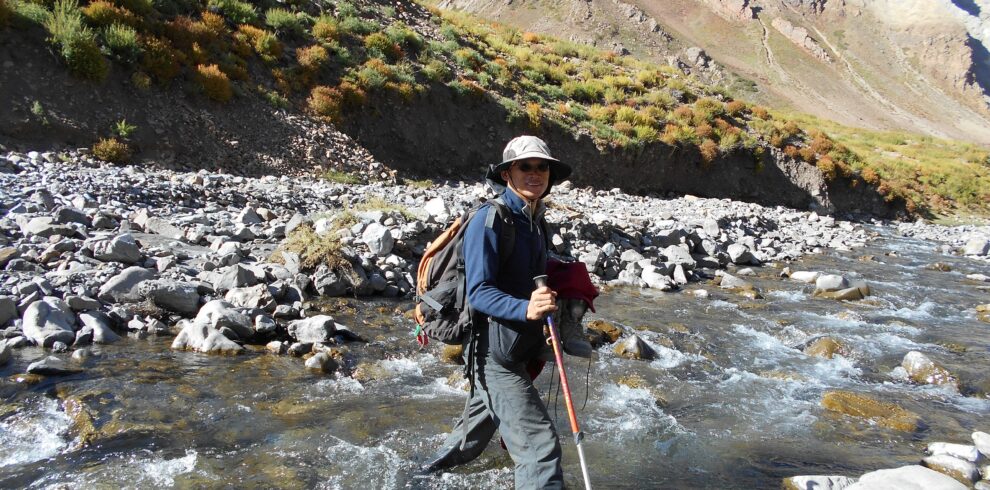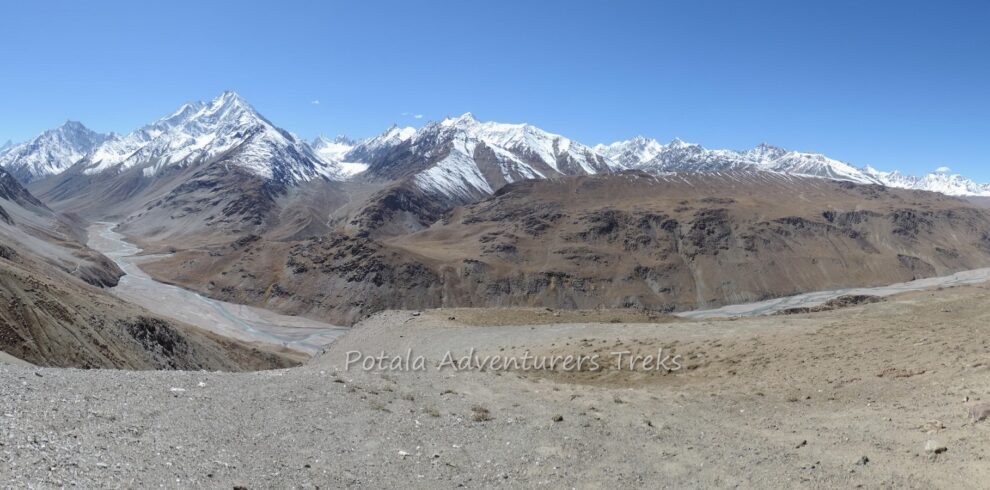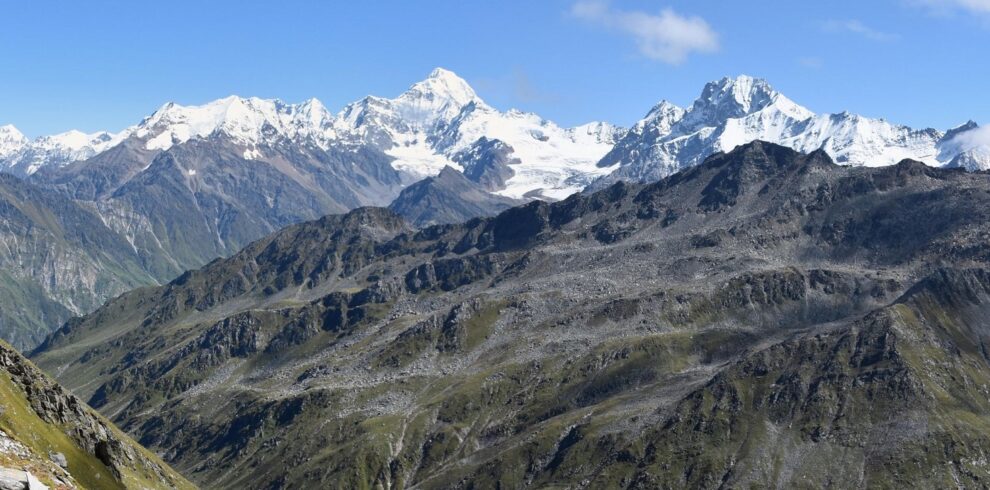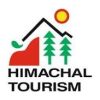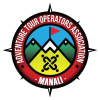The Miyar Valley, located in the Indian part of the Great Himalaya Range, stretches for over 100 km from Udaipur to the Kang La. The locals – the Tharanga people – are mainly shepherds and farmers much like the Gaddis but follow a curious mix of Hindu/Buddhist religion.
It is the westernmost of the Lahul valley‘s on the watershed between the Lahul & Zanskar in Ladakh, it’s known for its profusion of wildflowers and medicinal herbs especially during July and August, and its breathtaking landscape of quaint villages and rolling meadows which are replaced by glaciers and big rock walls as you move deeper into the valley. In recent years the valley has also attracted a lot of climbing teams (Teams from Slovenia, Poland, Italy, US, UK & India, and Spanish too, It is hosts hundreds of peaks that are, by Himalayan standards, accessible and low in altitude, with very few exceeding 6000 m. As a result, Alpine-style routes are possible here that have a technical standard not normally seen in the Himalayas. The wealth of climbing possibilities here led Chris Bonington to dub it as “the Yosemite of India”
Overview
The Miyar Valley, located in the Indian part of the Great Himalaya Range, stretches for over 100 km from Udaipur to the Kang La. The locals – the Tharanga people – are mainly shepherds and farmers much like the Gaddis but follow a curious mix of Hindu/Buddhist religion.
It is the westernmost of the Lahul valley‘s on the watershed between the Lahul & Zanskar in Ladakh, it’s known for its profusion of wildflowers and medicinal herbs especially during July and August, and its breathtaking landscape of quaint villages and rolling meadows which are replaced by glaciers and big rock walls as you move deeper into the valley. In recent years the valley has also attracted a lot of climbing teams (Teams from Slovenia, Poland, Italy, US, UK & India, and Spanish too, It is hosts hundreds of peaks that are, by Himalayan standards, accessible and low in altitude, with very few exceeding 6000 m. As a result, Alpine-style routes are possible here that have a technical standard not normally seen in the Himalayas. The wealth of climbing possibilities here led Chris Bonington to dub it as “the Yosemite of India”
Famous peaks in the area are: Menthosa 6443mtrs / 21260ft is the largest peak in the area. For trekkers, the Udaipur (Urgos road-head) -Kang La -Padum (Zanskar traverse) is quite popular another viable option is to link up the Chandra Valley and Miyar via the Taralumsa pass. Another interesting option would be the crossing of the Poat La pass which would link up the Kishtwar Region to the Miyar Valley.
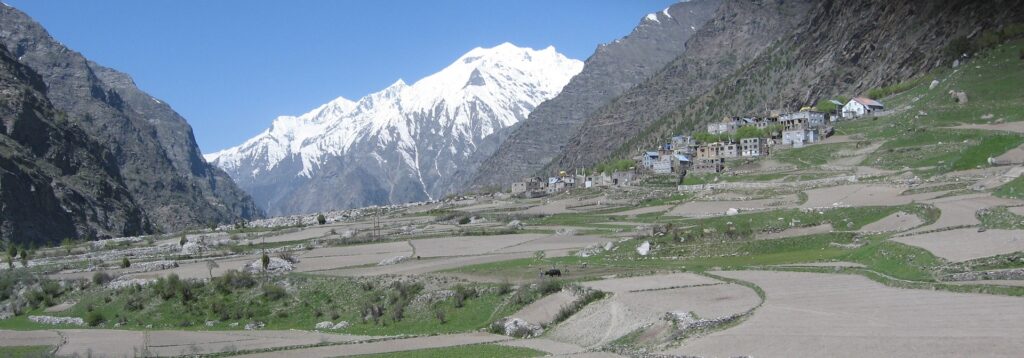
Itinerary
Day 1: Manali to Rohtang la pass (3,978m) – Udaipur (2650m) – Chamrat (2,090m) – Urgos (3,300m). Drive 7-8 Hrs.
Starting the trip from Manali, at the head of the lush green Kullu valley. The road slowly winds up the Rohtang-la pass (3’978m.), the first of the high passes, then down into the Lahoul valley. The landscape changes dramatically, the greenery being replaced by barren hillsides, where the village with its bountiful fields of barley, peas, and potatoes, stand out in stark contrast. On entering Lahoul the Buddhist influence is visible in the many monasteries crossed on the way. The people here have distinct Tibetan features. Today we drive along the Chenab River. On the way, we visit the famous Trilok Nath temple and Mrikula Devi temple at Udaipur. From Udaipur follow a road, which has recently been constructed, through the narrow gorge making the entrance to Miyar valley. Cross the wooden bridge before Chamrat and continue on the true left bank of the valley. The village of Chamrat is with Mani walls and prayer flags is the first village in the Miyar valley. Now road leads through flowered meadows and peas and millet fields to the village of Karpat. Urgos is at the confluence with the valley leading to Mt. Menthosa (6,443m), overnight homestay.
Day 2: Trek Shukto (3450m) – Khanjar (3520m) – Tharang (3,700m)
Leaving Urgos, we drive 6 km to Shukto – Khanjar bridge or you can trek on this route, across a stony moraine stretch and some side streams to Khanjar, the last village. above the village on a beautiful alpine meadow, carpeted with edelweiss and catmint. It is not rare to see the Himalayan Griffins and Lammergeyers.
There are lovely pastures all along the trek up to the camping site. The trek continues to the left side of the stream. A side stream coming from the Tharang glacier mingles here with the Miyar nullah. The camp is established here for tonight.
Day 3: Trek to Gumba nallah (3,800m) – Zardung (3880m)
Leaving Tharang base camp, crossing of ford and through boulders and to vast alpine meadows of Gumba. During summer all these areas carpeted with flowers. After hiking for two hours you reach Gumba nallah (3,800m) and cross the bridge and ascend gradually. Continue through the alpine pasture to Zardung campsite. Tharang group of 6000+ peaks remain insight this all day. There is a Takdung glacier stream to be cross next day and afternoon the level of the stream goes up. We camp before this stream in order to cross tomorrow when the level of water will be convenient for crossing.
Day 4: Trek to Palphu / Snout of Kang La glacier base camp (3950m)
Leaving early Takdung nallah to be cross this morning. After crossing an easy trail below the castle peak to Kesar Hunchap. Pimu nallah and Pimu la can be seen across the Miyar nallah. After lunch at Kesar Hunchap, another stream coming from Chodung glacier to be cross. It’s not so far from the campsite from here. Crystal clear lake short before our wonderful campsite at the foot of Kang La glacier. For those who are interested in bouldering, there is a number of boulders suitable for rock climbers. The entire Miyar valley is a favorite grazing area and Shepherds can be seen all across the valley, who know many trails that are not yet marked on maps. Arriving at camp, relax and explore around.
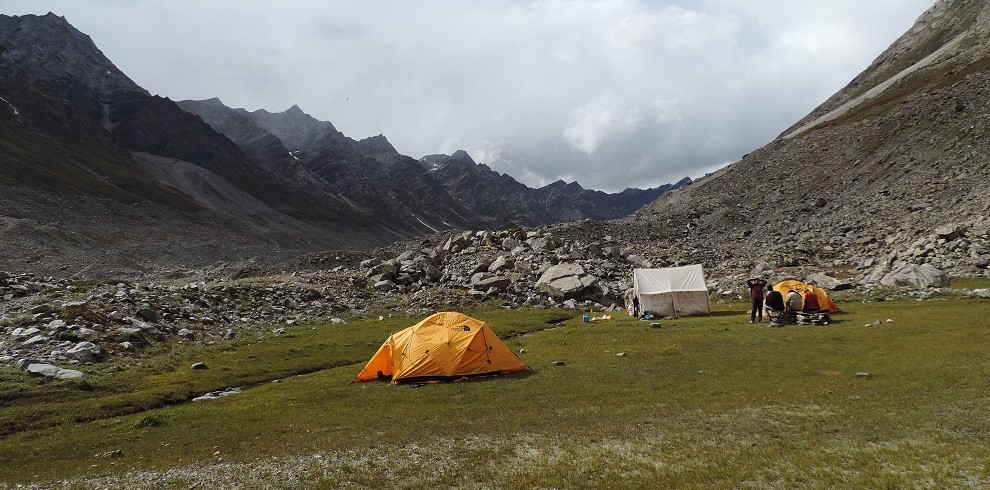
Day 5: At Moraine camp / Palphu – Acclimatize
Day 6: Trek to Glacier camp 1 Dali got / Tawa glacier (4,200m)
Today from camp climb steep along the slopes for about an hour than along the left side of the glacier for hours. Finally, descend to glacier and cross it to the campsite. The first view of the Kang la glacier can be obtained from here.
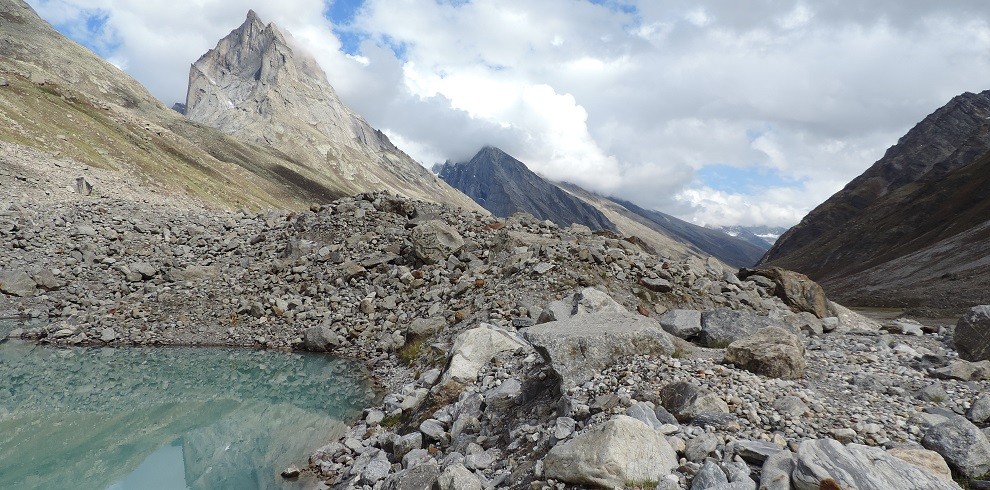
Day 7: Trek to Glacier camp 2 Jangpar glacier/ Base Kang la Jot (4750m)
Miyar glacier, which is 28 km long, from camp at the snout glacier there is a choice of route. Walk across the terminal moraine to the left side of the glacier, route tiring ups and downs along an increasingly ill-defined trail. Demanding terrains for the first 7/8 km until the confluence with a glacier flowing from the Eastside, easy going from here with a gradual ascent over smooth black ice. An occasional well-exposed crevasses to negotiate. Camp just above the confluence with the side glacier, there are 3 passes, and the center one is the actual pass.
Day 8: Cross Kang la jot (5450 m) – North base Kanjur / Chimi Chenmo (4800m)
A magnificent views down the valley to Menthosa 6443m. At the head of the glacier, a large snowfield curves to the Eastside to the base of the pass. 250 m ascent from the snowfield to the pass is not hard. Better to rope up to crossing crevasses, than 1.5 km long Kang la pass enclosed by rock cliff to the north and snow walls to the south. After crossing Kang la pass camp near the two confluences of the 2 streams.
Day 9: Trek Burdan, Drive to Purney.
Now follow the true right side of the valley. After crossing the many side streams and grassy campsites, 2/3 km down the valley. Arriving at a rocky plateau, the trail descends steeply in places through meadows and boulder fields. Tenasa Tokpo remains on the right bank, it flows down to a grassy meadow above the Tsarap River. Continue for 2 hrs to reach Burdan and drive to Purney for overnight stay.
Day 10: Purney to Keylong drive, over Shinkun La, Keylong to Manali.
Today after breakfast we drive along with the Kurgiakh chu and cross small villages of Southern Zanskar and arrive at Lakhong and the road goes up to Shinkun La pass and descent to Zanskar Sumdo. A good road will take us to Darcha and continue to Jispa and Keylong. A short drive of 3 hrs to reach Manali from Keylong via Atal Rohtang tunnel to Manali.


